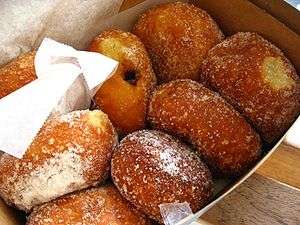Malasada
A malasada (Portuguese: malassada, from "mal-assada" = "under-cooked") (similar to filhós) is a Portuguese confection. It is a fried type of doughnut, made of small balls of yeast dough and coated with granulated sugar and sometimes cinnamon. The traditional Portuguese malasadas don't contain holes or any type of filling, but some variations do, especially the ones made in Hawaii. Malasadas are often eaten on Mardi Gras - the day before Ash Wednesday.
 Hawaiian version filled with custard, chocolate, haupia, and guava. | |
| Type | Fried dough |
|---|---|
| Place of origin | Portugal |
| Region or state | Azores, Madeira |
| Main ingredients | Dough, sugar |
| Variations | Bola de Berlim (Berlin Ball) |
In Madeira and in the Azores, malasadas are mainly eaten on Terça-feira Gorda (“Fat Tuesday” in English; Mardi Gras in French) which is also the day before Lent begins. It's a traditional confection eaten in the Azores islands and in Madeira during the Portuguese Carnival (Carnival of Madeira in the Madeira Islands). Malasadas were created with the intention of using all the lard and sugar in one's home, in preparation for Lent (similar to the tradition of the Shrove Tuesday in the United Kingdom, commonly incorrectly called Pancake Day). This tradition was taken to Hawaii, where they celebrate Shrove Tuesday, known as Malasada Day, which dates back to the days of the sugarcane plantations of the 19th century when the Portuguese (mostly from Madeira and the Azores) went to Hawaii to work in those plantations, bringing their Catholic traditions. These workers used up butter and sugar prior to Lent by making large batches of malasadas.
By region
United States
In 1878, Portuguese laborers from Madeira and the Azores went to Hawaii to work in the plantations. These immigrants brought their traditional foods with them, including a fried dough pastry called "malasada."[1] Today, there are numerous bakeries in the Hawaiian islands specializing in malasadas.[2]
On the East Coast, in Rhode Island, and Southeastern Massachusetts, there is also a high population of Portuguese-Americans. Festivals in towns such as New Bedford and Fall River will often serve Portuguese cuisine, including Malasadas.[3]
Mardi Gras ("Fat Tuesday"), the day before Lent, is Malasada Day in Hawaii. Being predominantly Catholic, Portuguese immigrants would need to use up all their butter and sugar prior to Lent. They did so by making large batches of malasadas, which they would subsequently share with friends from all the other ethnic groups in the plantation camps.[4]
In the United States, malasadas are cooked in many Portuguese or Portuguese descendant homes on Fat Tuesday. It is a tradition where the older children take the warm doughnuts and roll them in sugar while the eldest woman — mother or grandmother — cooks them.
See also
- List of doughnut varieties
- Carnival of Madeira
- Cuisine of Hawaii
- Filhós
- Leonard's Bakery – A Portuguese bakery in Hawaii that popularized the malasada in Hawaii
- Portuguese Cuisine
References
- Robert Carpenter; Cindy Carpenter (30 January 2008). Kauai Restaurants and Dining with Princeville and Poipu Beach. Holiday Publishing Inc. p. 26. ISBN 978-1-931752-37-4.
- Rachel Laudan (January 1996). The Food of Paradise: Exploring Hawaii's Culinary Heritage. University of Hawaii Press. p. 94. ISBN 978-0-8248-1778-7.
- Mimi Sheraton; Kelly Alexander (13 January 2015). 1,000 Foods to Eat Before You Die: A Food Lover's Life List. Workman Publishing Company, Incorporated. p. 274. ISBN 978-0-7611-4168-6.
- Jennifer McLagan (2008). Fat: An Appreciation of a Misunderstood Ingredient, With Recipes. Ten Speed Press. p. 115. ISBN 978-1-58008-935-7.
(2010) Patrick Andrews - "Pioneering the Malasada" Queensland, Australia. 2010
External links
| Wikimedia Commons has media related to Malasadas. |